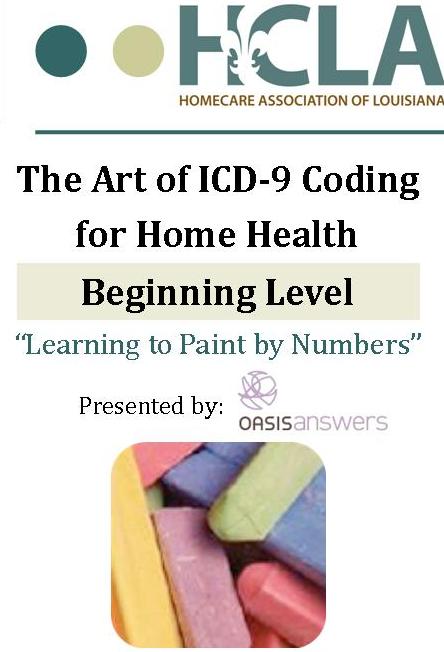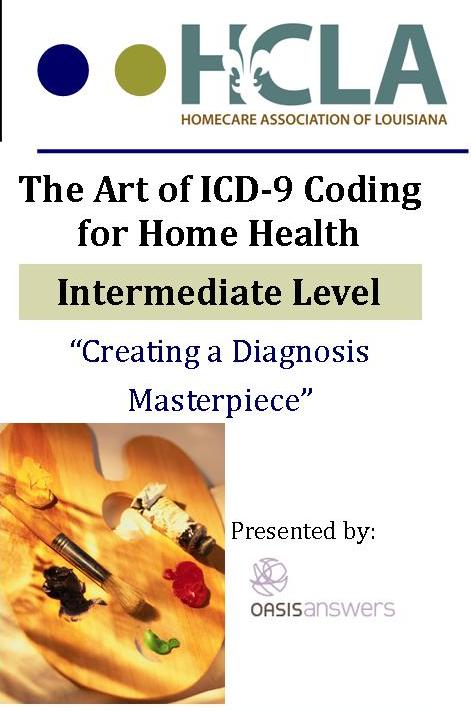What will you be doing on October 1, 2013? If you’re like all the other home health agencies you’ll be using the new ICD-10 diagnostic and procedural coding dataset. That implementation date was posted in the Federal Register a couple of years ago and is not expected to change.
Why must we change? Well for starters approximately 140 other countries are currently using ICD-10 and ICD-9-CM is getting full. With each passing year it gets harder and harder to add or further subdivide ICD-9 codes to reflect needed changes in the coding world.
What will ICD-10 look like? ICD-10 has two parts, ICD-10-CM and ICD-10-PCS. ICD-10-CM will replace Volumes 1 & 2 of the ICD-9-CM. (CM stands for clinical modification.) These sections contain the diagnostic codes. There are currently 14,025 diagnostic codes in ICD-9-CM. ICD-10-CM contains 68,069 codes. ICD-10-PCS will replace ICD-9-CM Volume 3, procedure codes. ICD-10-PCS lists 72,589 procedure codes, which is a vast increase over the 3,824 codes in ICD-9-CM.
ICD-9-CM has 17 chapters and 2 supplementary classifications for V & E codes. ICD-10-CM will separate the diagnostic codes into 21 chapters with the V & E codes incorporated into those chapters.
The codes themselves will also look different. In ICD-9 the codes may be up to 5 digits long. They are largely numeric codes but some are V and E codes. ICD-10 codes begin with a letter and are up to 7 digits long. This increased length will allow
for the differentiation between laterality (right vs. left) and initial vs. subsequent encounters.
Since there is such a disparity between the number and size of these codes how will we transition to this new version? Over the past 3 years both the Centers for Medicare & Medicaid Services (CMS) and Centers for Disease Control (CDC’s National Center for Health Statistics) have been working to develop General Equivalence Mappings (GEMs). These have been created with input from the other 2 of the 4 Cooperating Parties of the ICD-9-CM, the American Hospital Association and the American Health Information Management Association. These GEMs have been designed to act like bi-directional translational dictionaries. They can be used to convert payment systems, payment & coverage edits, risk adjustment logic, quality measures, and a variety of research applications involving data trends. These GEMs can be accessed at CMS’ website at http://www.cms.hhs.gov/ICD10/01m_2009_ICD10PCS.asp for procedure codes and http://www.cms.hhs.gov/ICD10/02m_2009_ICD_10_CM.asp for diagnostic codes.
Why do we need GEMs? ICD-10 is much more specific, and a few ICD-10-CM codes have no predecessor in ICD-9-CM codes. This is partly because there are new concepts in ICD-10 that are not considered in ICD-9-CM. To make matters worse sometimes an ICD-9-CM diagnosis code is represented by multiple ICD-10-CM codes and vice versa. Rarely is there a one-to-one match between ICD-9-CM and ICD-10. The GEMs not only translate between the two datasets, but also point out any differences between the two. Let’s look at a couple of examples.
The first example illustrates where one ICD-9-CM diagnosis code that is represented by multiple ICD-10-CM codes:
82002 Fracture of midcervical section of femur, closed
S72031A Displaced midcervical fracture of right femur, initial encounter for closed fracture
S72031G Displaced midcervical fracture of right femur, subsequent encounter for closed fracture with delayed healing
S72032A Displaced midcervical fracture of left femur, initial encounter for closed fracture
S72032G Displaced midcervical fracture of left femur, subsequent encounter for closed fracture with delayed healing
The next example shows one ICD-10-CM diagnosis code is represented by multiple ICD-9-CM codes:
E11341 Type 2 diabetes mellitus with severe nonproliferative diabetic retinopathy with macular edema
250.50 Diabetes with ophthalmic manifestations, type II or unspecified type, not stated as uncontrolled
362.06 Severe nonproliferative diabetic retinopathy
362.07 Diabetic macular edema
The GEMs also contain “Flags” which give information about the translations. They are numeric messages that point out if the translation is an approximate or an identical match or if there is no plausible translation.
The GEMs are crosswalks that allow analysis between the two datasets and to facilitate conversion between the two systems but they are not a substitute for learning ICD-10. Effective 10/1/2013 coders will use coding manuals or encoders to assign codes based on ICD-10. It is estimated that an experienced coder can learn ICD-10 in approximately 14 hours. We have 3 and ½ years to accomplish this feat. In the meantime we must stay proficient in the assignment of ICD-9-CM codes. Join us in Baton Rouge & Monroe in August & September while we focus on current coding information that we need now.

Sparkle Sparks PT MPT COS-C
Senior Associate Consultant
OASIS Answers, Inc.





Pingback: Anthem Medicare
Pingback: Aetna Medicare